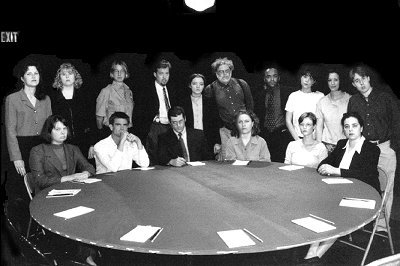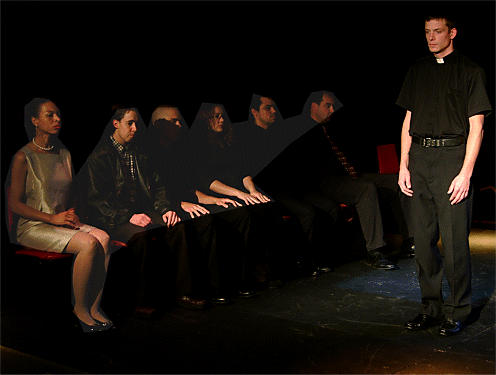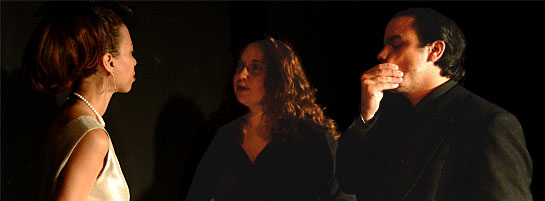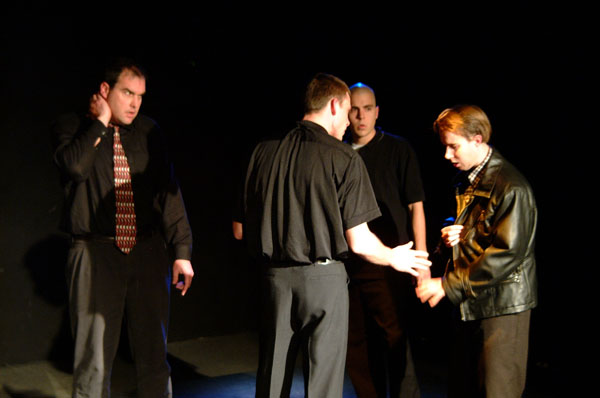![]()
The Actors Studio Session
What goes on in the Friday acting unit sessions? I’ll describe a session as it was when Lee Strasberg still roamed the earth with the rest of us mortals. I must emphasize that this was my experience at the Actors Studio-West. I’ve never even been inside the New York location.
The sessions run from 11:00 AM to 1:00 PM Fridays. Between ten and eleven, actors begin showing up. Some come early just to socialize with like minded artists. The actors who are working today might already be in the theatre space rehearsing, relaxing or otherwise preparing for the upcoming scene.
Once the moderator has arrived, people may start drifting into the theatre. They try not to disturb the actors who might be on the stage preparing.
At exactly eleven o’clock, not a minute later, the door is closed, which locks it from the outside. This means if you are a minute late, you are excluded from the first scene, and must wait until the break before you can enter the theatre. I’ve seen this unspoken rule broken on occasion, depending on who is sitting near the door inside and how desperate the latecomer is to get in. I’ve also seen “Stars” locked out because they were just a few minutes late.
At eleven, the moderator announces the first scene, house lights fade and stage lights come up, and the scene begins.
What exactly does “the scene begins” mean? You never know at the Actors Studio. You may notice no visible or auditory change whatsoever coming from the actors who might already be onstage. They may be still in preparation, attempting to create that first “moment of inspiration” that will lead into the corresponding first “moment of reality” in the lives they are living onstage. Or the preparation might lead them into the scene at exactly that moment.
Or you may end up observing an improvisation, without a single word of formal dialogue spoken throughout the entire scene. Possibly one actor is creating a sensory object while the other actor is rushing through the scene to deliver a “performance”.
In 1975 I saw a young Susan Peretz (who has passed way, God love her soul) do a scene from “The Jewish Wife” that was essentially no more than a “private moment” exercise. When I say “no more”, I am describing the perfect example of the phrase “less is more”. Without her speaking a word, I saw Ms. Peretz create a life so full, so rich and so very interesting that for at least fifteen minutes I completely forgot I was watching an actor on the stage. The empathy she created with her intense concentration kept me riveted to her “simple life” on the stage. It was an incredible learning experience for me in my first month observing at the Studio.
Basically, the variations of what you will see from scene to scene are endless, limited only by the experience and imaginations of the actors involved. For a full understanding of just what is happening on the stage, one has to be more than vaguely familiar with the “procedures” involved.
Then, often when you least expect it, one of the actors on the stage might call “scene”, and the scene is over.
The moderator at this point will ask the actors involved, “What would you like to tell us?”, or “What were you working on?”, or a similiar question. At this point, each actor will describe the process he or she used on this particular day to accomplish the work on the scene. This description might include the actor’s awareness of a specific problem he or she is experiencing in the work, and his or her desire to try to solve that problem.
At times, the choices made by the actors seem to have little or nothing whatsoever to do with what may seem obvious from the play. And you know what? That’s perfectly fine. The idea is to explore whatever “it” may be for the actor that will unlock the scene in the actor’s own unique way. This exploration can often seem illogical. For an “outsider” (of which there are usually none) this exploration might seem painfully boring or meaningless. But the members know better. The astute member is keenly observing every second of the scene, looking for indications of how the actor is, or is not, working properly.
After the actors explain whatever it is they attempted to accomplish, the moderator will then turn to the members and ask, “What would you like to say?”, or “Who would like to say anything?”, or a similar question, thereby opening up for discussion what has been observed on the stage.
Members, often from different backgrounds, try to keep their comments directed specifically to whatever it was the actors were trying to accomplish. Most members are very comfortable with the terminology of the “method”, which makes communication in the room often delightful. If a member’s comments become “directorial” rather than “observational”, the moderator will usually interrupt to remind the member that “directing” the scene is not the purpose of the moment.
It is not unusual at this point of the session for the actors on the stage to at times express feelings of defensiveness. Everyone has been in the “hot seat” at one time or another, but every time one returns to it, one finds unwanted tension creeping in sub-consciously. It’s hard to fight it. Although the actor knows he or she is not being “attacked” or even, for that matter, criticized, there’s something fragile about the artistic soul that causes it to shrivel at the slightest indication that some sort of failure might be present in its ability to express itself as beautifully as its own self-perception has at times taken for granted.
After member comments, the moderator takes over the discussion with what are usually final observations. I say usually, because at times certain moderators might ask the actors to re-work the scene, or part of the scene while trying an exercise, or exploring a possibility. Then there may be more discussion before the moderator makes his finishing statements. When this part of the process has completed, the members take a fifteen minute break to allow the next set of actors to setup and prepare for the next scene. After the break, the second hour is just like the first, except, of course, the scene and attending observations will be very, very different.
From my own personal experience as an actor, I can say there is not much in my artistic life that quite compares to the euphoric joy of fellowship with this group of like minded artists banded together for a common purpose, that of helping their fellows solve the problems that actors have faced for centuries, and will continue to face as long as the earth remains inhabited by human beings.




